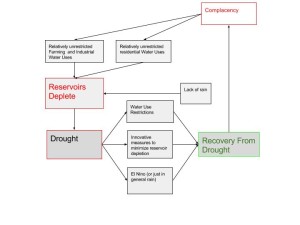- Create a system diagram describing a local issue covering sustainability or conservation in your area.
- Describe how the issue is being approached in the area and the affect of action or inaction with regards to the the issue.
This is once again addressing the drought that has taken hold of California. While there are actions that are accounting for the loss of water from the reservoirs and the lack and of rain. California’s reservoirs almost function cyclically and the cycle is based around El Nino. The reservoirs, the farms, and local water sources all work with the existing interconnected water sources, melting snow cap, and El Nino mostly to replenish their supply. An increasingly hot couple of non El Nino years coupled with increased farming and increased population have lead to the current drought situation in California which has created a dynamic that requires governance to preserve the water sources in California. There were restrictions that were placed on water usage for watering yard plants and were placed on the use of water with regards to washing your vehicles, and recommendations for general water use reduction in the household. Those restrictions are a look at the micro, whereas there was innovation that was required when looking at the macro, looking at the larger water reservoirs and possible ways to prevent the loss of water. One such innovation was the use of millions of black polyethylene balls in major reservoirs to prevent the evaporation of such water sources, the balls were also used as a preventative measure for preventing the production of bromide by chemical reactions activated by sunlight between bromine that occurs naturally in the water sources and chlorine which was used to disinfect drinking water. “Called shade balls, 80 million of the hollow black orbs are needed to cover the reservoirs in Los Angeles to stop sunlight from triggering a potentially dangerous chemical reaction between bromite, which occurs naturally in groundwater, and the chlorine used to disinfect drinking water.”(Plastic News, 2014). These innovative new practices and restrictions coupled with the most recent El Nino have shown that net positive changes can be made.
Net positive changes are good, even though after the most recent rainy season we are still a great distance away from recovery from the drought a more pessimistic view can look at the cycle and see the repetition. The approach to the water crisis has been reactionary, the consensus from everyone I have met has been a tiredness from governance and contrary to a sustainable approach to the idea. While innovation like the black polyethylene balls with be permanent changes, governance and water use restrictions will not be, once the state is clear of the drought the restrictions will be lifted and relatively unrestricted water use will be restored. What needs to happen is massive education on conservation and sustainability, or complacency will take hold and there will be a return to the situation that got the state to the situation that it is in. The water sources have shown a significant amount of resilience with regards to the the drought and the significantly warmer and dry periods between El Nino’s and the dwindling snow caps. What needs to happen for proper sustainability is the maintaining of the water use policies by the government to assist in sustainable water use as a permanent policy not as a reactionary policy.
References
Plastic News. “Plastic balls protect California Water Sources.” Last Modified January 3, 2014. http://www.plasticsnews.com/article/20140103/NEWS/140109973/plastic-balls-protect-california-reservoirs




